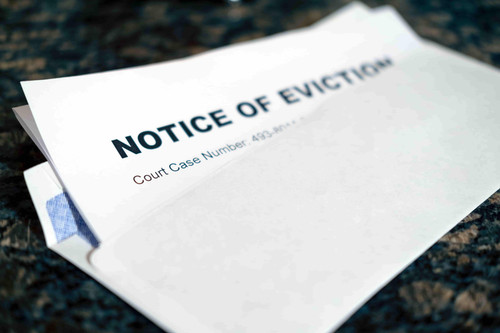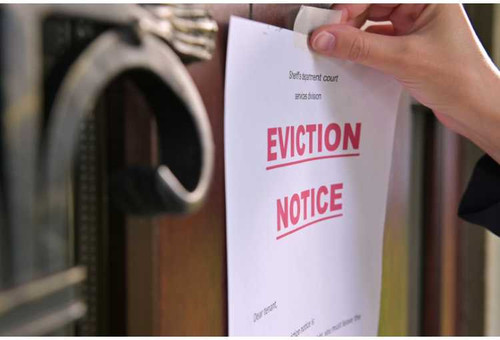How the Storage Unit Eviction Process Works in 2026
Are you looking to shuffle tenants at your storage facility? Learn the legal steps and best practices for a smooth and compliant storage unit eviction process.

Eviction can be a daunting process for self storage facility owners. It’s emotionally and legally complicated, and it can be challenging to know where to start.
What are the legal requirements to start with? And do they differ based on location?
Also, how do you protect yourself and your facility during the eviction process?
Even if you’ve previously evicted a client, the law constantly changes, and keeping up with the latest developments can be challenging. That’s why we’ve put together this comprehensive guide for storage facility owners on the current storage unit eviction process.
We’ll cover all the basics you need to know—whether in the US, UK, or elsewhere—including legal requirements, tips on handling evictions more effectively, and what to do after the eviction process.
Manage Evictions with Confidence
Get our Ultimate Self-Storage Business Ebook, and master the essentials of eviction process.
When You Can Evict Clients: Non-Payment and Lease Violations
As a self storage facility owner, you have many responsibilities to ensure your business runs smoothly and that you get the payments you deserve. One of these responsibilities is evicting clients when there’s a rental agreement violation.
In the US, there are two main reasons why a client may be evicted, and they include:
- Non-payment
- Lease violation
For example, in the state of Illinois, if a tenant fails to pay their rent a day after it’s due, this can be classified as non-payment and is enough grounds for eviction. However, the storage facility owner is required to provide a five-day notice to pay, after which he may proceed with the eviction process.

Similarly, if a tenant violates the rental agreement, such as storing items not allowed as outlined in our storage unit laws guide, they may also be evicted.
Regardless of the case, it’s essential to ensure any eviction process is done within legal guidelines and with proper documentation.

Why Strong Lease Agreements Are Essential
Clear, comprehensive lease agreements are the foundation of a lawful and efficient eviction process. Without precisely drafted terms covering access policies, payment requirements, prohibited items, liability clauses, and grounds for termination, eviction actions may not hold up legally. Facility owners should make sure every lease is signed and includes all necessary conditions to protect both parties and set proper expectations from the outset. Displaying signage inside your facility about prohibited items can further reduce disputes and confusion, minimizing operational risk.
Detailed Lease Violation Identification and Documentation
To ensure a smooth and legally sound eviction process, it is essential to accurately identify and document any lease violations. Common violations that lead to eviction include non-payment of rent, storing prohibited items (such as hazardous materials or firearms), illegal activity (like drug storage or theft), exceeding storage limits, improper use of the unit (living or conducting business inside), property damage, and health or safety hazards.
Document each violation with clear records, including dates, evidence (photos, written notices), and correspondence with the tenant. This documentation strengthens your case if legal action becomes necessary.
How Do You Evict Someone From a Storage Unit in the UK?
If you’re managing a storage facility in the UK, you’ll need to understand the laws and processes for evicting a tenant in your unit. Eviction proceedings differ for each country, so knowing what’s expected of you in the UK is essential.
Inventory and Valuation of Tenant Property
Before selling or disposing of a tenant’s belongings, conduct a thorough inventory and valuation. In the UK, this is a required step before auctioning goods. In the US, while not always mandated, documenting contents protects your business from disputes. List all items, take photos, and estimate their value. This process provides transparency and helps avoid claims of mishandling or loss.
The British Consumer Law
The British consumer law states that you must provide reasonable notice to tenants not complying with their contractual obligations. This means you’ll need to warn the tenant before evicting them, but the notice doesn’t have to be in written form.
The notice can be a Section 21 notice if you want the unit after the tenant finishes a fixed term or a Section 8 notice if the tenant has broken the tenancy term.
The Legal Process of Evicting a Tenant in the UK
If your warning goes ignored, then you can proceed with eviction proceedings, which involve these steps:
1. Apply to the court for a standard possession order if your tenant has unpaid rent. In a case where they don’t owe you rent, you can apply for an accelerated possession order.
2. If your tenant still refuses to vacate the storage unit, obtain and execute a warrant of possession. This allows court bailiffs or police officers to take possession of the property.
It’s important to precisely follow these steps as outlined by British consumer law. If not, any eviction may be considered unlawful and open you to legal repercussions or potential fines.

To be on the safer side, you should always keep an updated record of your storage units and their tenants across multiple locations. This will give you enough evidence to prove that your tenant is “guilty as charged.” Storeganise’s self storage software is a great tool for managing your self storage units effectively across multiple locations. It helps with keeping detailed records with comprehensive data analytics.
Storage Unit Eviction Laws and Processes in the US
When evicting a tenant from a storage unit in the US, you must follow the law to comply with the storage unit renters’ rights.
Generally speaking, the storage unit eviction process follows these steps:
1. Provide notice
2. File an eviction lawsuit.
3. Garnish wages and bank accounts.
4. Take over the self storage unit.
Step1: Provide Notice.
You must present proper written notice to the tenant to vacate the premises or remedy any defaults within a specific time frame. The time you’re allowed to give depends on your state’s laws. In Illinois, for example, you’re required to give a five-day written notice.
Step 2: File an Eviction Lawsuit.
If the tenant doesn’t respond to your notice, you can file an eviction lawsuit against them in court. This step is required even if you don’t intend to pursue it further than filing — it establishes that you followed due process if needed. Once you’ve made the filing, you must serve the client at least three days before the hearing.
Step 3: Garnish Wages and Bank Accounts.
Depending on your state, you may be able to garnish wages and bank accounts of tenants who owe rent or fees for damages or unpaid bills. Again, your state’s laws will determine whether this is an option for you in the storage unit eviction process and how much money can be garnished immediately.
Step 4: Take Over the Self Storage Unit.
Once all other legal requirements have been met, you can seek possession of the self storage unit via court. The tenant must move out after 14 or 7 days if they’re being evicted for illegal activities. If they fail to comply, you’re legally allowed to throw out their belongings.
Step 5: Auction and Lien Process for Nonpayment
If a tenant fails to pay rent despite notice, the next step is often a lien sale. After providing a final written notice to the tenant, you must publicly announce the auction according to state law. This notice should specify the date, time, and location of the auction, as well as the contents being sold.
Conduct the auction in compliance with legal requirements, including using a licensed auctioneer and documenting all steps. The proceeds from the sale are applied to the unpaid rent and fees; any excess must be returned to the tenant as required by law. Always check your state’s specific regulations for lien sales and auctions.
Protection From Storage Eviction Under the SCRA
Being a storage facility owner, you might wonder if there are any protections from storage eviction under the Servicemembers Civil Relief Act (SCRA).
The answer is yes. The SCRA provides additional protections against eviction and rent collection to active-duty military service members. It sets different conditions under which deployed service members may be evicted or have their goods sold for nonpayment of rent while they’re away from the premises.
If you’re considering evicting a tenant eligible for SCRA protection, you must know you can’t outrightly serve them eviction notices. Military personnel on active duty are legally protected to occupy a storage unit for up to 90 days (three months) after their term ends to enable them to focus on their duty.

It’s best to consult your lawyer for the proper storage unit eviction process before taking any step, as they’ll be more knowledgeable about such laws.
State-by-State Considerations and Legal Risks
Eviction timelines and procedures vary significantly by state. For example, Texas requires specific forms and notice periods depending on the reason for eviction. Familiarize yourself with your state’s requirements for notices, court filings, and auctions.
Failure to follow state laws can result in legal action against your facility. Always consult with a legal professional to ensure compliance and to understand the risks and potential consequences of improper eviction.
Next Steps After Eviction: Re-Renting the Storage Unit
When a tenant is evicted, it’s important to remember that the storage unit can still be rented out again. As the facility owner, you may need to ensure the unit is clean and ready for a new customer.
To re-rent the storage unit, you’ll need to do the following:
- Make sure your rental agreement policies are up-to-date and compliant with local and federal laws.
- Inspect the property to ensure it’s clean and in good condition according to legal standards. This updated 2024 self storage maintenance checklist should be a great resource.
- Reset the lock on the unit so a new renter can move in securely. You may consult our storage facility security guide for more details.
- Re-list your unit as available online or onsite.
- Document all activity related to renting out the unit, including any payments made, deposits taken, etc.
- Utilise Storeganise software for your self storage business, which will store all the updated information about your units in one place for easy remote access and management.
Tenant Screening and Prevention Tools
Utilize tenant screening tools to minimize the risk of eviction. Background checks, credit reports, and rental history reviews help identify reliable tenants. Automated management software can streamline rent collection, send reminders, and maintain detailed records, reducing the likelihood of missed payments and violations.
How to Avoid Evictions and Manage Difficult Tenants
Preventing evictions starts with proactive tenant management. Implement thorough tenant screening by checking credit history, rental references, and previous behavior. Use automated payment reminders and insist on automatic payments to reduce late payments.
For difficult tenants, maintain professional and consistent communication. Address issues early, and document all interactions. Offering flexible payment plans or mediation options can help resolve disputes before eviction becomes necessary. Building a positive relationship with tenants can prevent conflicts and reduce the likelihood of violations.
Wrapping It Up
In short, the storage unit eviction process is complicated and highly regulated in the US and the UK. Still, it can be managed easily with proper knowledge and planning. When faced with an eviction, follow the law and take all the necessary steps to keep your facility and renters safe.
Storeganise provides the perfect platform to ensure all legal requirements are followed, providing the necessary documents for a smooth eviction process. So, make sure you make the most of our revolutionary software to protect your business and customers. Our platform also offers an excellent means to re-list your storage unit for contactless online bookings after a successful eviction process, so consider signing up for a free trial today!
Storage Unit Eviction Process FAQs
How Long Does It Take to Evict a Tenant?
The eviction process can take several weeks to several months in the UK. In the US, it can range from a few weeks to several months, but the exact time frame depends on the state and local laws, the reason for the eviction, and the court’s backlog. The process can take much longer if the tenant refuses to cooperate.
How Long Can You Go without Paying for Storage?
Typically, you can go for 30 days without paying for storage. In the UK and the US, the time frame for defaulting and facing an auction for unpaid storage fees generally ranges between 30 and 90 days. However, the public storage late payment grace period varies depending on the specific contract terms and local lien laws.
What Happens to a Storage Unit When Someone Dies in the UK?
When someone dies in the UK and has a storage unit, the estate executor handles the deceased’s possessions. To access the unit or take over the storage hire agreement, the executor must provide the storage facility with a copy of the death certificate and a court order confirming their role as the executor. Once the necessary documentation is provided, the executor can decide whether to remove the possessions or continue the storage agreement.
What happens when storage is not paid?
If storage fees are not paid, the facility typically issues late fees and notices. Eventually, if the balance remains unpaid, the facility may auction off the contents to recover the unpaid rent.
Can storage go on your credit?
Yes, if storage fees are unpaid and the debt is sent to collections, it can be reported to credit agencies, negatively impacting your credit score until the debt is resolved.
What happens if I leave things in a storage unit?
If you leave items in a storage unit without paying or giving notice, the facility may consider it abandoned. After due notice, they may auction off the contents to recover costs.
What happens if you go over your storage?
If you exceed your storage unit’s size or weight limits, the facility might ask you to rent a larger unit, pay additional fees, or remove the excess items to comply with their policies.
What happens if you don't pay your storage in Texas?
In Texas, if you don’t pay for a storage unit, the facility is legally allowed to place a lien on the contents. After giving proper notice, they can auction the items to recover unpaid fees.
